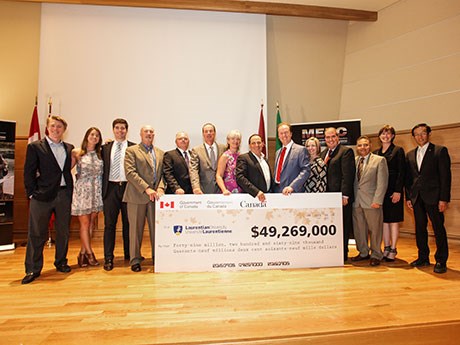L.U. Earth Sciences Department wins funding for $104 million Metal Earth research program
If Laurentian University’s Earth Sciences Department wasn’t already the leading geoscience academic and research centre in Canada, two huge funding announcements on September 6th remove any doubt as to its preeminence.
The day began modestly enough with the announcement of a $10 million gift from David Harquail, president and CEO of Franco-Nevada Corporation and the renaming of the department as the Harquail School of Earth Sciences. Then, later in the day, a collection of local Members of Parliament and Minister of Science Kristy Duncan announced a $49,269,000 contribution from the Canada First Research Excellence Fund for an ambitious, seven-year research program called Metal Earth.
With $55 million in cash and in-kind contributions from 22 partnering organizations, the value of the Metal Earth research program totals $104 million.
“One of the largest impediments facing the mineral exploration industry is the difficulty of identifying metal endowed areas from the vast areas that are less endowed but geologically similar,” said Dr. Harold Gibson, director of Laurentian University’s Mineral Exploration Research Centre and Metal Earth lead.
“Targeting greenfield exploration is an enormous problem because you have vast areas that in appearance look geologically similar. The industry is quite capable of finding deposits when they’re in the right area, but the challenge is in narrowing down to that area.”
Solving the problem requires a better understanding of metals during Earth’s early evolution, said Gibson.
“Our research will approach this problem from different scales. The first and largest will be at the scale of cratons.
We’re going to undertake a massive compilation of all geophysical, geochronological and geochemical data for the Superior Province and part of the Slave Province.
“We will also use the huge zircon archives, which are available from our provincial and federal partners and do very careful isotopic work. By combining the isotopic data with the actual ages, we can produce time slices where we can examine the evolution, architecture and metallogeny of our shield areas.
“Our mantle group will examine the composition of mantle xenoliths in kimberlites to determine what the mantle conditions were at different intervals of time during the evolution of the Superior Province.
“Then we’re going to focus on precise transects. The transects will range from 40 to 100 kilometres long and be several kilometres wide. The transects are located to cross areas where we know there’s incredible metal endowment and across geologically similar areas where there is less or no metal endowment. Along the transects, for the first time, we’ll be integrating new seismic, magnetotelluric and gravity data and existing geophysical data coupled with the new geological and geochemical data that we’re going to glean from the geology at surface. The integration and visualization of all this data will result in 3D slices through the crust to the mantle in these areas so we can make comparisons. We’ll be doing this in the Abitibi and Wabigoon greenstone belts, looking at endowed, less endowed areas, and then in Nunavut in the Hope Bay belt.
“The transects, for the first time, will provide virtual MRIs through our crust down to 40 plus kilometres. By doing that, we hope to see differences, determine why those differences exist and learn what data we have to collect data to explore for areas that are endowed.”
This will be followed by thematic studies at the scale of individual deposits, mining districts and greenstone belts to try to resolve problems identified from the cratonic and transect research.
“A really important part of Metal Earth,” said Gibson, “is the data analysis. “We’re going to produce huge amounts of data, and this data has to be integrated. It’s going to be tied in space in X, Y and Z co-ordinates, and hopefully even in time with the isotopic work. We have to find new ways to organize this data, interrogate it properly and then visualize it. We need to develop new data analytic methods to understand sparse, non-uniform and complex multi-parameter geoscience data in 3D and in 4D, so we’re going to break a lot of new ground.
“All of the new data that we collect is going to be available to the public in formats they can use.”
While the focus will be on Canada, the outcomes will be applicable globally, said Gibson.
“There’s no better shield in the world to do this. We have the best exposed, the best understood and best preserved shield. We also have some of the world’s best ore deposit districts here, so this is a great area to do it.”
Among the partnering organizations are the geological surveys of Canada, Ontario, Quebec, Manitoba, the North West Territories and Nunavut, five universities in Canada and three universities in Australia. Also partnering with Metal Earth are TMAC Resources, Noront Resources, Vale, Mira Geoscience, the Carnegie Institute for Science, the Centre for Exploration Targeting and the Centre of Excellence in Ore Deposits in Australia, the Northern Ontario Heritage Fund Corporation, the Centre for Excellence in Mining Innovation and MIRARCO.
Metal Earth will recruit over 35 post-docs, provide training for 80 to 90 graduate students and allow for the hiring of four new faculty, including a research chair in exploration targeting, and professors with expertise in Precambrian geology, earth systems modeling and exploration geophysics.
Ultimately, the objective of Metal Earth, said Gibson, is to aid in the discovery of new orebodies.
“Global metal reserves are being depleted due to increased demand and decreased global discovery rates over the past 10 years. We’ve had substantial increases in exploration expenditures up to the recent recession, but for the first time in our history, we don’t have the discoveries to show for it. Metal Earth is a new approach. It goes beyond traditional research at deposit or district scale. It will transform how we explore for metals and our understanding of Earth’s early evolution.”



.jpg;w=120;h=80;mode=crop)